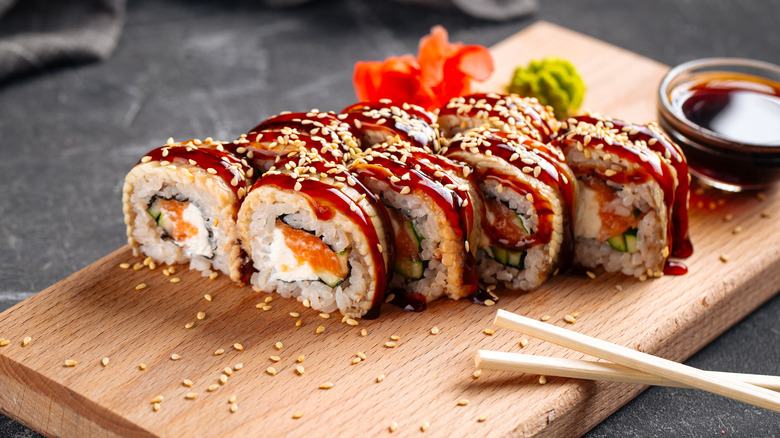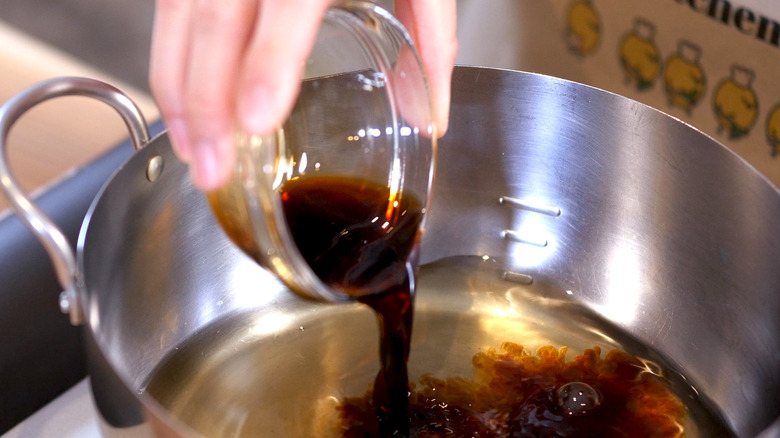Eel Sauce Is The Umami-Rich Condiment You Should Know About
We may receive a commission on purchases made from links.
In a bustling sushi restaurant, an entranced diner may come into contact with a glossy brown sauce adorning their eel sushi. This umami-rich condiment, known as unagi or eel sauce, boasts a divine flavor that enhances the thin fish that surrounds the rice and seaweed — but its ability to elevate isn't exclusive to just sushi.
Despite its nomenclature, eel sauce these days, at least in America, usually contains no real eel. Westernized eel sauce's origins trace back to Japan, where it was born from a sauce called nitsume, and nitsume is crafted from conger eel broth. As Japanese cuisine migrated to the U.S., eel sauce was likely adapted to cater to Western and diverse palates, where eel seldom graces restaurant menus, other than at sushi and Asian restaurants, and is rarely available in mainstream supermarkets.
Although it contains no traces of eel, eel sauce has not lost appeal. Rather, its allure has increased in the culinary world, offering a deep savory flavor as a sauce and marinade. So if you've had the opportunity to enjoy this sauce at your favorite sushi spot, you may wonder how it's made. And despite its complex flavors, it is just as easy to craft at home.
Eel sauce is satisfying and easy to make at home
To make eel sauce, you'll need four pantry-essential ingredients: soy sauce, sake (or Japanese rice wine), mirin (or sweet Japanese rice wine), and brown or white sugar. These ingredients are mixed, simmered, and reduced in a saucepan until a glossy, syrupy brown sauce, thick enough to coat the back of a spoon, emerges.
While we recommend enjoying home-crafted eel sauce immediately, this tasty condiment has a rather long shelf life thanks to its preserving salt and sugar components. This makes eel sauce a great addition to any home pantry. In an airtight container, eel sauce can last in the refrigerator for up to 2 weeks and up to 3 months in the freezer.
As you experiment with homemade eel sauce, you can immediately see how it can effortlessly elevate various dishes beyond eel sushi and poke bowls.
How to cook with and where to buy eel sauce
For instance, when stir-frying, add eel sauce to incorporate a layer of complexity. Use it as a marinade for different proteins or a roasted ham and poultry glaze. Eel sauce can also be incorporated into your salad dressings or used as a drizzle over steamed or blanched vegetables, like gai lan, for an unexpected punch of umami.
To experiment further, consider desserts: a decadent chocolate cupcake frosted with eel sauce-infused buttercream. The sweet and salty balance of the eel sauce in the frosting could provide an intriguing counterpart to the semi-sweet chocolate base.
And what about eel sauce as an ice cream syrup? Drizzled sparingly over a scoop of creamy vanilla, the eel sauce could add a surprisingly delightful note. Note how Asian baking and Asian desserts often balance sweet and savory flavors — for instance, mitarashi dango or Japanese skewered mochi dumplings are beautifully glazed with a sweetened soy sauce similar to eel sauce.
To purchase eel sauce, you should be able to find it easily at any Asian or mainstream supermarket on the condiment or international foods aisle. But if your store is short, you can choose from plenty of brands online via Amazon or Bokksu Market.


